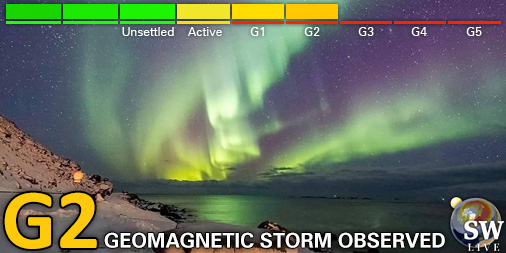Viewing archive of Monday, 10 March 2014
Daily bulletin on solar and geomagnetic activity from the SIDC
Issued: 2014 Mar 10 1308 UTC
SIDC Forecast
Solar flares
Active (M-class flares expected, probability >=50%)
Geomagnetism
Quiet (A<20 and K<4)
Solar protons
Quiet
| 10cm flux | Ap | |
|---|---|---|
| 10 Mar 2014 | 146 | 009 |
| 11 Mar 2014 | 146 | 007 |
| 12 Mar 2014 | 146 | 007 |
Bulletin
There were four low M flares and twelve C flares on the Sun during the past 24 hours, the large majority being released by NOAA AR 12002. The brightest one was an M1.1 flare from NOAA AR 12002 peaking at 00:26 UT on March 10. In the next 48 hours, the probability for C flares is very high (over 95%) and for M flares around 70%, mainly from beta-gamma-delta region NOAA AR 12002. An X flare is possible but unlikely. The halo CME detected by CACTUS on LASCO C2 imagery from 3:12 UT on March 9, is probably a backsided event related to an eruption in NOAA AR 11986, as can be seen in STEREO B images. This CME is not expected to be geoeffective. Since 12h UT on March 9, solar wind speed as observed by ACE decreased from around 340 km/s to around 270 km/s around 0h UT on March 10, while the magnitude of the Interplanetary Magnetic Field (IMF) varied between 1.5 and 4.5 nT in this period. From then onwards, solar wind speed increased again to about 340 km/s, with the magnitude of the IMF fluctuating between 1.5 and 6 nT. Over the past 24 hours, geomagnetic conditions were quiet (K Dourbes between 0 and 3; NOAA Kp between 0 and 3). Quiet geomagnetic levels are expected on March 10, 11, and 12.
Today's estimated international sunspot number (ISN): 083, based on 17 stations.Solar indices for 09 Mar 2014
| Wolf number Catania | /// |
| 10cm solar flux | 146 |
| AK Chambon La Forêt | /// |
| AK Wingst | 004 |
| Estimated Ap | 003 |
| Estimated international sunspot number | 080 - Based on 25 stations |
Noticeable events summary
| Day | Begin | Max | End | Loc | Strength | OP | 10cm | Catania/NOAA | Radio burst types |
|---|---|---|---|---|---|---|---|---|---|
| 09 | 1352 | 1358 | 1405 | S17E58 | M1.0 | SN | --/2002 | ||
| 09 | 2013 | 2028 | 2035 | S19E54 | M1.0 | SF | --/2002 | ||
| 10 | 0019 | 0026 | 0033 | S19E52 | M1.1 | SF | 73/2002 | ||
| 10 | 0402 | 0408 | 0413 | ---- | M1.0 | 73/2002 |
Provided by the Solar Influences Data analysis Center© - SIDC - Processed by SpaceWeatherLive
All times in UTC
Current data suggests there is a moderate possibility for aurora to appear at the following middle latitude regions in the near future
SurgutCurrent data suggests there is a slight possibility for aurora to appear at the following middle latitude regions in the near future
Yakutsk, YekaterinburgLatest news
Latest forum messages
Support SpaceWeatherLive.com!
A lot of people come to SpaceWeatherLive to follow the Sun's activity or if there is aurora to be seen, but with more traffic comes higher server costs. Consider a donation if you enjoy SpaceWeatherLive so we can keep the website online!

Latest alerts
15:30 UTC - Geomagnetic activity
Minor G1 geomagnetic storm (Kp5) Threshold Reached: 15:20 UTC
14:30 UTC - Geomagnetic activity
Strong G3 geomagnetic storm (Kp7) Threshold Reached: 14:18 UTC
13:30 UTC - Geomagnetic activity
Moderate G2 geomagnetic storm (Kp6) Threshold Reached: 13:21 UTC
13:18 UTC - Hemispheric Power Index
The OVATION model predicts the Hemispheric Power Index to reach 125GW at 14:01 UTC
13:15 UTC - Geomagnetic activity
Minor G1 geomagnetic storm (Kp5) Threshold Reached: 13:13 UTC
Space weather facts
| Last X-flare | 2025/03/28 | X1.1 |
| Last M-flare | 2025/04/15 | M1.2 |
| Last geomagnetic storm | 2025/04/15 | Kp6+ (G2) |
| Spotless days | |
|---|---|
| Last spotless day | 2022/06/08 |
| Monthly mean Sunspot Number | |
|---|---|
| March 2025 | 134.2 -20.4 |
| April 2025 | 124.1 -10.1 |
| Last 30 days | 124.7 -16.6 |






